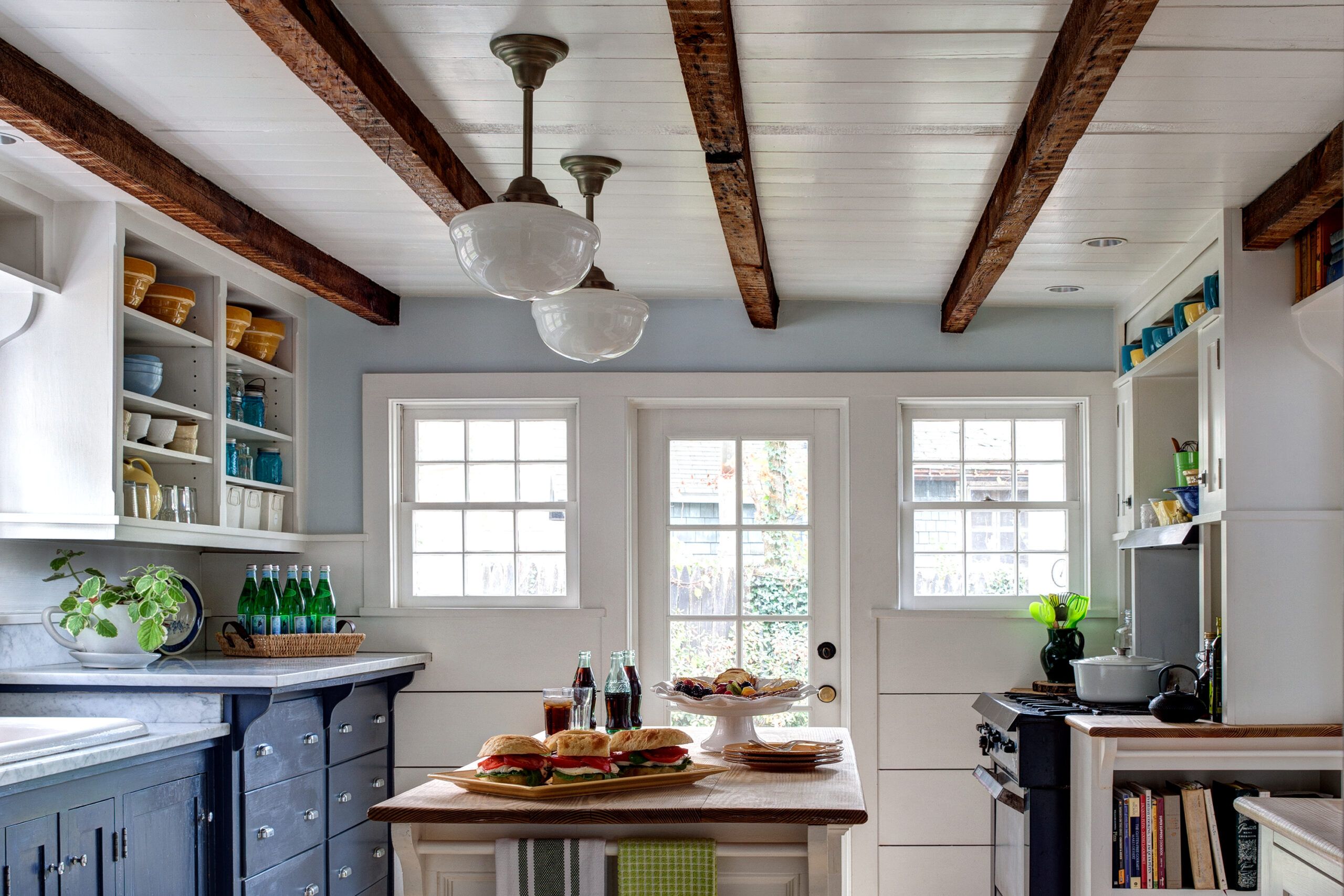Exposed beams add warmth and character to any space. If you don’t already have them in your home, you can achieve the look with faux wood beams. There are lightweight, easy-to-install options in various styles and finishes. In this article, we’ll explain what to know before installing faux wood beams in your home and provide some real-world examples for design inspiration.
The Basics of Faux Wood Beams
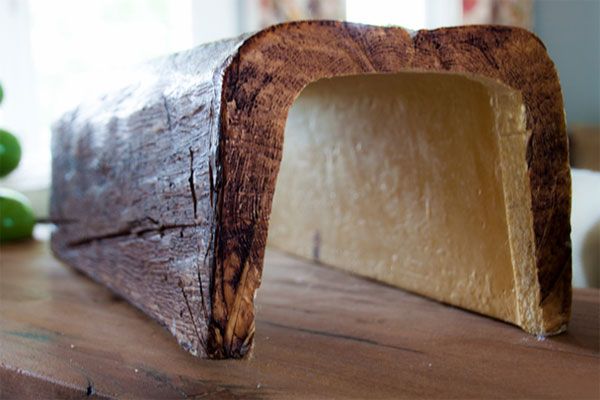
Faux wood beams are made from materials like high-density polyurethane foam or lightweight wood, offering the look of real wood beams without the weight, cost, and installation challenges. Here are some things to consider before installing them.
Scale and Proportion
The size and spacing of your faux wood beams can dramatically impact the feel of your room. Think about the height of your ceilings, the size of your space, and the desired spacing between beams to create a visually balanced design.
- Ceiling height: In rooms with low ceilings, opt for narrower beams to avoid a cramped feeling. For high ceilings, wider beams can create a dramatic statement.
- Beam length: Most faux wood beams come in standard lengths, but you can often order custom sizes if needed.
- Beam spacing: The spacing between beams can affect the overall feel of the room. Closer spacing can create a cozy, intimate atmosphere, while wider spacing feels more open and airy.
- Room size: In a small space, a few beams can be enough to add visual interest, while larger rooms might benefit from a more extensive beam layout.
Placement and Arrangement
Where you place your beams can be just as important as their size. While installing wood beams on the ceiling is the most common, faux wood beams can also add interest to walls, furniture, and even outdoor spaces. Here are some ideas for other ways to use them:
- Accent wall: Create a stunning backdrop with a vertical or horizontal arrangement of faux wood beams.
- Asymmetrical layout: Arrange the beams asymmetrically for a more organic and dynamic look.
- Ceiling grid: A classic grid arrangement on the ceiling adds symmetry and order, which is ideal for traditional or formal spaces.
- Central beam: A single, bold beam along the ceiling draws the eye upward and creates a focal point in the room.
- Custom furniture: Incorporate faux wood beams into custom furniture pieces like headboards, tables, benches, or shelving units.
- Door and window frames: Frame doorways and windows with faux wood beams to add architectural detail and warmth.
- Lighting integration: Integrate lighting fixtures, such as LED strip lighting or recessed lights, into the beams for a unique and functional design element.
- Outdoor spaces: Use faux wood beams in covered patios, pergolas, and outdoor kitchens.
- Visual divider: Use beams to subtly define zones within an open floor plan or break up a large, blank wall.
Materials, Styles, and Finishes
Faux wood beams come in a wide array of materials, styles, and finishes to align with your desired style.
- Color and stain: Faux wood beams can be painted or stained to match your existing wood tones or flooring. Alternatively, you can choose a bolder color for contrast.
- Material composition: Faux wood beams are typically made from polyurethane foam or polyvinyl chloride (PVC), making them lightweight, durable, and resistant to warping and cracking. Real wood is more expensive and requires more expertise to install.
- Rustic vs. modern: Faux wood beams are available in a wide range of styles, from rough-hewn and distressed to sleek and modern. Choose a style that complements your overall design scheme.
- Texture: Some faux wood beams have a smooth finish, while others mimic the natural texture of wood grain. Think about the desired feel and look of your space when choosing a texture.
5 Ideas for Faux Wood Beams From Real Projects
We asked five home bloggers to share their ideas for affordably incorporating the wood-beam look. From period-style bathrooms to rustic kitchens, these projects showcase the versatility of faux wood beams and the dramatic impact they can have on a room.
Period-Style Primary Bath
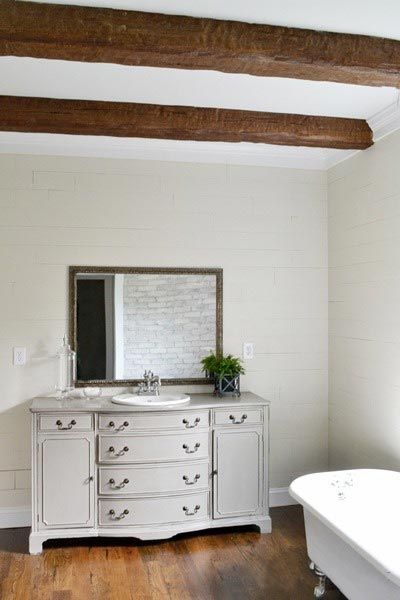
Traci from Beneath My Heart fell in love with the look of ceiling beams while browsing on Pinterest. She incorporated faux beams in her primary bathroom to complement a refinished claw-foot tub and an antique dresser-turned-vanity. She was impressed with how easy they were to install—she says she and her young sons could have done the work themselves.
See how they completed the project: Installing Faux Wood Beams in Our Primary Bathroom
Fake-Out Family Room
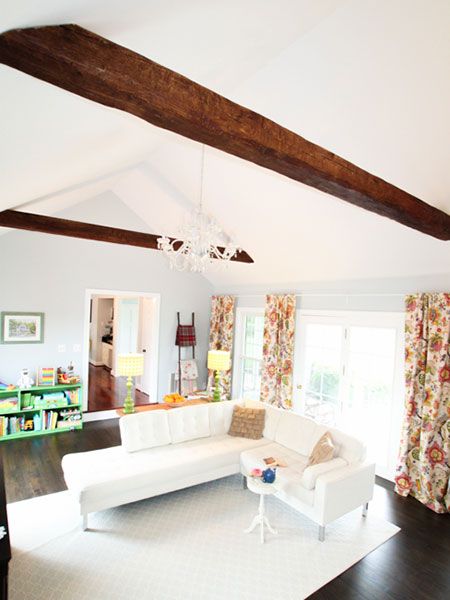
The price of aged wood beams deterred Heather of The Heathered Nest—until she discovered how to fake the look. She and her husband used faux beams to add rustic flare and architectural detail to their family room’s high cathedral ceiling. They found the beams at The Home Depot.
Read more about Heather’s project here.
Farmhouse-Style Bedroom
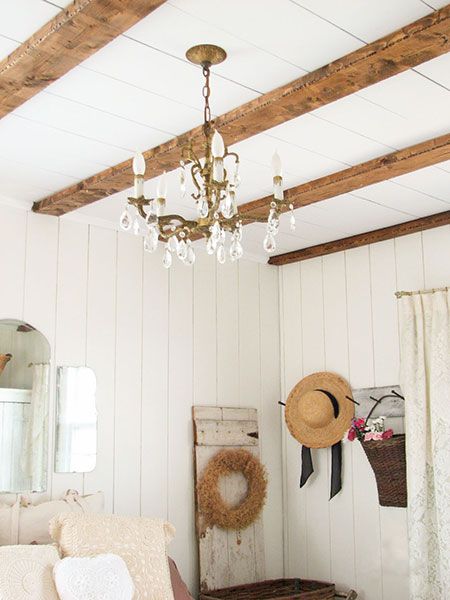
In a yearlong overhaul of her primary bedroom, Larissa of Prodigal Pieces made over an old stippled ceiling. Instead of a faux, engineered wood style, she bought simple pine beams and distressed them to get the rustic look she wanted.
See more photos and how they completed the ceiling: Farmhouse Primary Bedroom Grand Finale
Wood-Framed Doorway
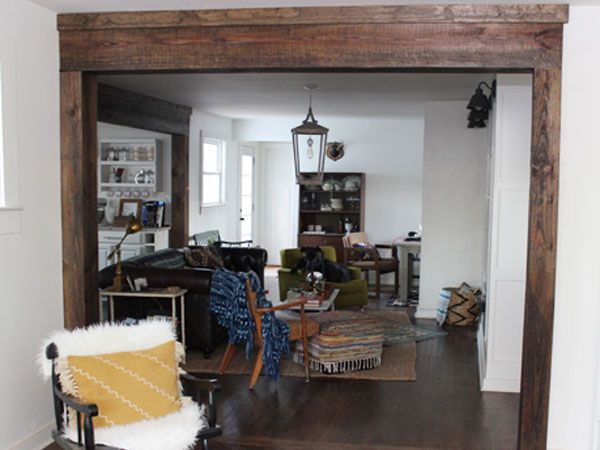
To create the look of a chunky, solid-wood beam-and-column duo in room-dividing doorways, Lindsay of The White Buffalo Styling Co. used framing lumber to build out and hide the smaller support beams. Their contractor was able to nail the framing lumber directly onto the existing beam. For the columns, they used three boards nailed into the drywall. They added a dark wood stain to complete the look.
See how she did it: Creating Faux Wood Beams
Rustic Kitchen Ceiling on a Budget
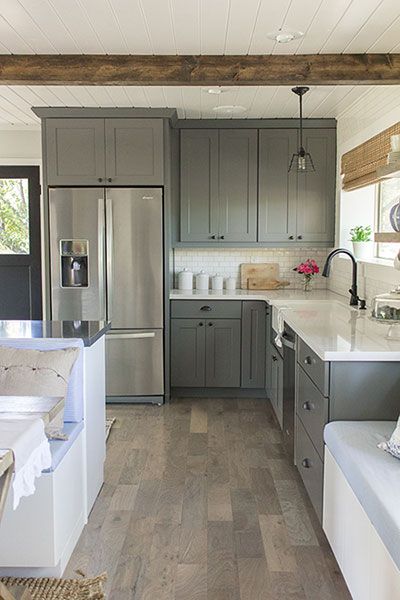
When Jenna of Jenna Sue Design Co. searched for a home, wood beams were on her wish list. When the house she ended up with didn’t have any, she decided to investigate options to add them. She was surprised to find that even faux wood wasn’t in her budget. Instead, she built the decorative beams she wanted out of inexpensive whitewood.
See the DIY tutorial: Kitchen Chronicles: DIY Wood Beams
More Ways To Use Faux Wood Beams
With creativity, you can find endless ways to use faux wood beams to elevate your design and create a space that’s uniquely yours. Here are some more suggestions for incorporating them into your home:
- Add architectural interest and focal points: A single, large faux wood beam running across a ceiling can create a dramatic statement piece and serve as a focal point for the room. Use crisscrossing beams in a grid pattern to add visual interest and break up a large, monotonous ceiling. Introduce beams perpendicular to existing ceiling beams to create a coffered effect, adding depth and texture.
- Conceal flaws or imperfections: Faux wood beams can cleverly hide unsightly elements like cracks in the ceiling, uneven surfaces, or exposed wiring. Use beams to cover up outdated popcorn ceilings or stippled textures. Strategically placed beams can also camouflage seams between different ceiling materials.
- Create the illusion of higher ceilings: In rooms with low ceilings, install narrower faux wood beams painted in a lighter color than the ceiling. This creates a visual trick that draws the eye upward, making the space feel taller and more airy. You can go for a coffered ceiling design, where beams create recessed panels, adding depth and dimension to the ceiling while maintaining an open, airy feel.
- Define spaces within an open floor plan: In open-concept homes, faux wood beams can be strategically placed to delineate different functional areas without the need for walls. For example, a beam can visually separate a dining area from a living room or a kitchen from a family room. Use beams of different widths or colors to differentiate zones within the open space subtly.
- Focus on a particular style: Faux wood beams cater to various design tastes. For a rustic farmhouse, choose distressed beams in natural tones. Opt for smooth, painted beams for a traditional feel. Weathered beams with exposed hardware give industrial chic vibes, while darker, hand-hewn beams with a patina create a Mediterranean ambiance.
- Warm up a modern look: The organic texture of wood, even in faux form, can soften the sharp lines and minimalist feel of a modern space. Introduce a few rustic beams in a contemporary living room to add warmth and character without overwhelming the design. Pair faux wood beams with metal accents or industrial-style lighting for an eclectic, modern-industrial look.
Tips for Installing Faux Wood Beams
Depending on your skill level and the project’s complexity, you may be able to install faux wood beams yourself. However, we recommend hiring a professional for intricate designs or heavier beams. Here are a few tips to keep in mind:
- Fasten the beams securely: To prevent them from shifting or falling, make sure the beams are firmly attached to the ceiling or wall. Use appropriate mounting hardware and adhesive, as recommended by the manufacturer.
- Finish strong: Once the beams are installed, apply a finish to protect them. This could be a stain, paint, or clear sealant.
- Follow the manufacturer’s instructions: Each type of faux wood beam may have specific installation requirements, so be sure to read the instructions carefully.
- Mind the gaps: If there are any gaps between the beams and the ceiling or wall, fill them with caulk or wood filler for a seamless look.
- Planning is key: Before you start, carefully plan the layout and placement of your beams. Mark the positions on your ceiling or walls to create a symmetrical and balanced look.
- Put safety first: Wear safety goggles and gloves when cutting or drilling. Use a sturdy ladder when working overhead.
- Use the right tools: Gather all the necessary tools, including a stud finder, level, saw, drill, and screwdriver, before you begin.
Patience and attention to detail will go a long way in having a successful installation and a beautiful finished product. If you’re unsure about any aspect of the process, consult a professional for guidance.
